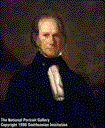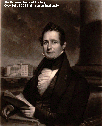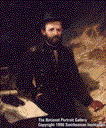

The Civil War
More Americans died during the Civil War from 1861-1865 than in any other war, ever. While these dates may define the period of war action, in fact the Civil War was the result of a long, history of complex issues of such things as Constitutional interpretation, economics, and the ethics of slavery. Below are brief sketches of only a few of the memorable names from that era of U.S. history. Also online at the Smithsonian is a collection of Civil War photographs by Mathew Brady.
 George Peter Alexander Healy (1813-1894)
George Peter Alexander Healy (1813-1894)
Oil on canvas, circa 1845, NPG.65.44
National Portrait Gallery,
Smithsonian Institution, Washington, D.C.
Transfer from the National Gallery of Art; gift of Andew W. Mellon, 1942
Henry Clay was one of the most influential congressmen of the early 1800s, with a political career that spanned nearly fifty years. Born in the midst of the American Revolution, he devoted his professional energy to the preservation of the union of the states in the stormy years preceding the Civil War. To that end, he crafted several key compromises between the North and the South, for which he became known as "The Great Pacificator." But even his legendary statesmanship could not keep war from erupting nine years after his death.
Differing interpretations of the Constitution were at the heart of the Civil War. Clay and other supporters of the Union insisted that states were subject to federal authority, while others, most notably South Carolina's John C. Calhoun, argued that states had the power to overrule federal legislation.
Clay was much respected, and served variously as a senator, Speaker of the House of Representatives, and secretary of state. However, Clay was never popular enough to win the presidency, despite running three times, in 1824, 1832, and again in 1844. However, he never lived down the charge of having made a "corrupt bargain" in the 1824 election when as Speaker of the House he withdrew his candidacy and threw his support to John Quincy Adams, who subsequently defeated rival Andrew Jackson and then made Clay his secretary of state. One such attack even led to a duel to defend his honor against congressman John Ralph.
Throughout his career, Clay advocated internal improvements such as interstate roads, which he hoped would foster national unity. He is perhaps best known as the principal author of the Compromise of 1850, which attempted to preserve the Union. Unfortunately this compromise only delayed the inevitable Civil War, rather than prevent it.
 John Sartain (1808-1897)
John Sartain (1808-1897)
Mezzotint, 1838, after Jacob Eichhotz, NPG.79.74
National Portrait Gallery,
Smithsonian Institution, Washington, D.C.
As a congressman from Pennsylvania, Thaddeus Stevens led the powerful Radical Republicans after the Civil War. Radical Republicans were a faction of the Republican party interested in freeing slaves and creating an egalitarian environment. His plan to reconstruct the South featured extremely harsh penalties for defeated confederates, such as the Wade Davis Bill, and strict measures to guarantee the rights of ex-slaves. When President Andrew Johnson opposed his plan in favor of more lenient policies, Stevens led an unsuccessful congressional effort to impeach him. Biographer Carl Sandburg described Stevens as "at his worst a clubfooted wrangler possessed of endless javelins, at his best a majestic and isolated figure . . . seeking to bring justice between man and man." At his death Stevens requested to be buried not among statesmen, but with African Americans he felt had been so wronged. His self-written epitaph reads "Equality of man before his Creator."
 Arvid
Frederick Nyholm (1866-1927)
Arvid
Frederick Nyholm (1866-1927)
Oil on canvas, 1912, after 1862 photograph by Mathew Brady, NPG.66.54
National Portrait Gallery,
Smithsonian Institution, Washington, D.C.
Transfer from the National Museum of American Art; gift of the Swedish
American Republican League of Illinois to the Smithsonian Institution, 1912
Swedish-born inventor John Ericsson is best known for constructing the USS Monitor, one of the North's first "ironclads," or armored warships. The South also built armored ships under the direction of John L. Porter--most notably the Virginia (formerly the USS Merrimack). These two ships met at Hampton Roads, near Norfolk, Virginia, in 1862. The four-hour battle ended in a draw; the Virginia possessed superior firepower, but the Monitor was more maneuverable. Though the first ironclads were unwieldy and often had mechanical problems, the success of their armor was immediately apparent, leading to a new generation of metal-plated ships.
 Edward Caledon Bruce (1825-1901)
Edward Caledon Bruce (1825-1901)
Oil on canvas, 1864-1865, NPG.76.4
National Portrait Gallery,
Smithsonian Institution, Washington, D.C.
As commander of the Army of Northern Virginia, Robert E. Lee was perhaps the most brilliant tactician of the Civil War. Though his military genius earned him universal praise, Lee's dignified and honorable character made him respected and well-liked by leaders on both sides. Ulysses S. Grant, commander of the northern armies, commented, "I felt like anything rather than rejoicing at the downfall of a foe who had fought so long and valiantly, and had suffered so much for a cause."
Lee began his military career at the U.S. Military Academy at West Point, serving later as a captain in the war with Mexico. His talent and dedication as an officer were quickly noticed by superiors, and further demonstrated by his quick defeat of John Brown's attempt to start a rebellion at Harpers Ferry, Virginia, in 1859. On the eve of the Civil War, Lee felt duty-bound to defend his native Virginia and so quit they U.S. Army to become commander in chief of the Army of Northern Virginia. Lee's armies won several decisive victories early in the conflict, even though they were always outnumbered by opposing forces. However, the weary southern armies could not stand up to the North's superior resources and relentless pursuit later in the war. For many, his surrender to Grant at Appomattox Court House on April 9, 1865 signified the end of the war.
 George Peter Alexander Healy (1813-1894)
George Peter Alexander Healy (1813-1894)
Oil on canvas, 1887, NPG.65.50
National Portrait Gallery,
Smithsonian Institution, Washington, D.C.
Transfer from the National Gallery of Art; gift of Andrew W. Mellon,
1942
Nobody had high expectations for Abraham Lincoln's presidency after he was elected to office with less than 40 percent of the popular vote. On the contrary, the elevation of Lincoln's Republican party, which was against the expansion of slavery, to power in 1861 launched the South's secession from the union and a bloody civil conflict. However, in turning the tide of war and reining in his political opponents, the thoughtful, compassionate Lincoln acquired a reputation of heroic proportions. Then, as now, he was credited with abolishing slavery and preserving the Union.
Lincoln's Emancipation Proclamation of 1863 freed slaves in territories controlled by the Confederacy. Though some called the pronouncement impotent and irrelevant, most people recognized the far-reaching impact it would have if the Union prevailed in the Civil War. Lincoln was assassinated by John Wilkes Booth in 1865.
 Begun by John Elliott (1858-1925) and finished by William H. Cotton
(1880-1958)
Begun by John Elliott (1858-1925) and finished by William H. Cotton
(1880-1958)
Oil on canvas, circa 1910 and circa 1925, NPG.65.31
National Portrait Gallery,
Smithsonian Institution, Washington, D.C.
Transfer from the National Museum of American Art; gift of Mrs. John
Elliott to the Smithsonian Institution, 1933
When Julia Ward Howe penned the words to the patriotic "Battle Hymn of the Republic" in 1861, little did she know that it would become the North's most popular anthem by the end of the Civil War; nor could she guess that her words would still be familiar to Americans more than a century later. Today Howe's fame as a songwriter eclipses her significant work as a reformer.
Before the Civil War, Howe was an eager abolitionist. However, her husband, fellow reformer Samuel Gridley Howe, restricted her activity outside the home. After the war, despite (or perhaps to spite) her husband, she became increasingly involved in the feminist movement. In 1869, with Lucy Stone and Henry Blackwell, Howe helped found the American Woman Suffrage Association. At suffrage rallies, women often sang "Battle Hymn of the Republic" in Howe's honor.
 Ole Peter Hansen Balling (1823-1906)
Ole Peter Hansen Balling (1823-1906)
Oil on canvas, 1865, NPG.67.34
National Portrait Gallery,
Smithsonian Institution, Washington, D.C.
Like Robert E. Lee, Ulysses S. Grant began his military career at West Point and then served in the Mexican War. Unhappy with subsequent assignments in the West, he resigned his commission in 1854 and turned to farming and business in Missouri, only to take it up again seven years later at the outset of the Civil War. Little was expected of him as an officer, but he soon surprised everyone with several stunning victories on the western front. Assuming command of the entire Union army in 1864, Grant successfully engineered the South's defeat in a little over a year.
His military accomplishments made him a prime political candidate, and in 1869 he became America's eighteenth president. While Grant's performance in the White House was lackluster and detached--inviting corruption in his administration--he remained popular among voters. Because Grant is more remembered for the scandals of his administration, many of his successes remain forgotten. Grant was sometimes criticized for a lack of sophistication befitting an American president ("I know only two tunes; one of them is 'Yankee Doodle' and the other isn't") .
LINKS
Henry Clay
Thaddeus Stevens
John Ericsson
Robert E. Lee
Abraham Lincoln
Julia Ward Howe
Ulysses S. Grant